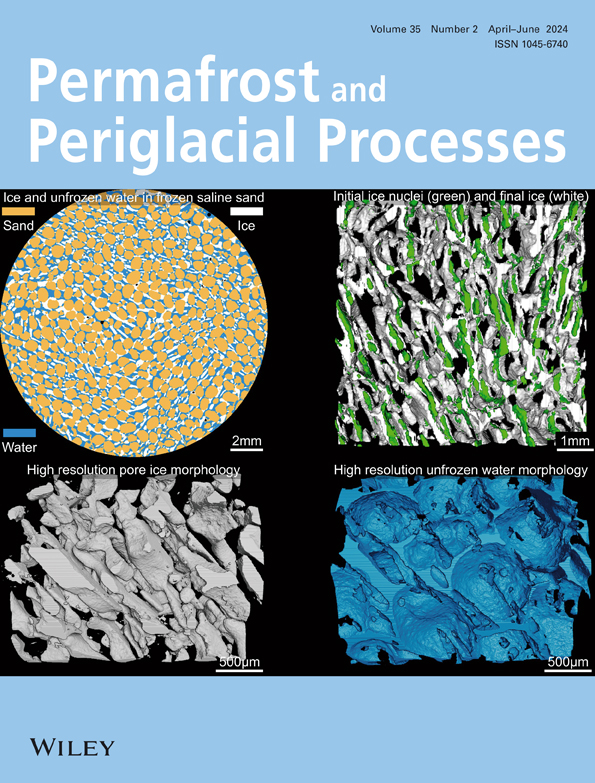西伯利亚西北部Messoyakha和pessovoe pingos冰芯形成标志的稳定氧、氢同位素组成
IF 3.3
3区 地球科学
Q2 GEOGRAPHY, PHYSICAL
引用次数: 1
摘要
Pingos是现代和过去永久冻土条件的指标。在西伯利亚西部的亚马尔半岛和吉丹半岛上总共发现了1620只平果。本研究的主要目的是考虑在开放和封闭系统条件下形成的平果冰芯中稳定同位素的分布。西伯利亚西北部连续多年冻土带中来自不同来源冰芯的两个pingo被认为是:Messoyaha‐1 pingo(高度10.5米)和Pessovoe pingo(17 高度为m)。冰芯的钻探是通过对未扰动的冷冻芯进行连续采样来进行的。根据封闭系统与开放系统框架中的瑞利分馏来估计冰的形成。对于Pessovoe pingo,δ18O值显著降低,dexc随深度相应增加,这表明塔里克湖从上到下结冰时是一个封闭系统。对于Messoyakha‐1 pingo,δ18O和δ2Н的值显示出随深度减小的微弱趋势,dexc的值随机变化。上覆和下伏沉积物中分离的冰的δ18O和δ2Н值相似,坡度较低。对于在封闭系统中分离的冰和在开放到半封闭系统中形成的冰芯,建立了同位素非平衡冰的形成。从周围湖泊或塔里克湖吸水的真空机制可能在Messoyakha‐1 pingo上部冰芯的形成及其额外生长过程中发挥了重要作用。本文章由计算机程序翻译,如有差异,请以英文原文为准。
Stable oxygen and hydrogen isotope compositions of the Messoyakha and Pestsovoe pingos in northwest Siberia as markers of ice core formation
Pingos are indicators of modern and past conditions of permafrost. In total, 1,620 pingos have been identified on the Yamal and Gydan peninsulas in western Siberia. The main purpose of this study is to consider the distribution of stable isotopes in pingo ice cores formed under conditions of open and closed systems. Two pingos from ice cores of different origin in the continuous permafrost zone of northwest Siberia have been considered: the Messoyaha‐1 pingo (10.5 m in height) and the Pestsovoe pingo (17 m in height). Drilling of the ice core was performed with continuous sampling of an undisturbed frozen core. Ice formation was estimated according to the Rayleigh fractionation in a closed‐system versus an open‐system framework. For the Pestsovoe pingo, a pronounced decrease in δ18O values with corresponding increase in dexc with depth indicates a closed system upon freezing of the lake talik from the top down. For the Messoyakha‐1 pingo, the values of δ18O and δ2Н showed a weak tendency to decrease with depth, with values of dexc varying randomly. Ice that was segregated in the overlying and underlying sediments had similar values of δ18O and δ2Н and a low slope. Isotopically nonequilibrium ice formation was established for ice which had been segregated in a closed system and for ice cores formed in an open to semiclosed system. The vacuum mechanism of water suction from the surrounding lake or lake talik may have played a significant role during the formation of the upper ice core of the Messoyakha‐1 pingo and its additional growth.
求助全文
通过发布文献求助,成功后即可免费获取论文全文。
去求助
来源期刊
CiteScore
9.70
自引率
8.00%
发文量
43
审稿时长
>12 weeks
期刊介绍:
Permafrost and Periglacial Processes is an international journal dedicated to the rapid publication of scientific and technical papers concerned with earth surface cryogenic processes, landforms and sediments present in a variety of (Sub) Arctic, Antarctic and High Mountain environments. It provides an efficient vehicle of communication amongst those with an interest in the cold, non-glacial geosciences. The focus is on (1) original research based on geomorphological, hydrological, sedimentological, geotechnical and engineering aspects of these areas and (2) original research carried out upon relict features where the objective has been to reconstruct the nature of the processes and/or palaeoenvironments which gave rise to these features, as opposed to purely stratigraphical considerations. The journal also publishes short communications, reviews, discussions and book reviews. The high scientific standard, interdisciplinary character and worldwide representation of PPP are maintained by regional editorial support and a rigorous refereeing system.

 求助内容:
求助内容: 应助结果提醒方式:
应助结果提醒方式:


